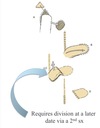Skin flaps, Skin grafts (slide 6, 7, 13) Flashcards
What is the order of graft incorporation? (4)
- Adherence 2. Plasmatic Imbibition 3. Inosculation 4. Vascular Ingrowth
****State the stage of graft incorporation and at the timeline *****
- -Anastomosis of cut ends of graft vessels with recipient bed (trying to kiss each other)
48/72 hours to 6 days ****Inosculation
State the stage of graft incorporation and at the timeline:
- Ingrowth of new vessels from the bed into graft (new lymph vessels by day 4 or 5 - 0.5 mm/day -Controlled by cytokines (just like in open wounds) -Re-innervation (feeling) (around 3 weeks) careful of paresthesia
Vascular Ingrowth (48hours) to (6-8 days)
State the stage of graft incorporation and at the timeline:
- -Graft vessels dilate and pull fibrinogen free, serum like fluid and cells into graft via capillary action -Nourishes wound prior to blood vessel development
Plasmatic Imbibition (0-72 + hours)
State the stage of graft incorporation and at the timeline: ?
- -Phase 1- contraction of fibrin strands (pull graft closer to bed)
- -Phase 2- fibrin to fibroblasts, leukocytes, phagocytes—> fibrous adhesion
Adherence Phase 1: 0-72 hours Phase 2: (72 hours - 10 days)
Fill in the blanks


Describe what Flull thickness MESHED skin grafts are?
Numerous slits cut in parallel, staggered rows to allow the graft to expand in 2 directions to increase size.
In full thickness meshed skin grafts, what does the meshing provide: _____, _____, _____?
Meshing provides:
- Drainage
- Flexibility
- Conformity
What are the indications for full thickness meshed skin grafts?
___1____
___2____
___3____
- Allow drainage from a wound with minor exudate (bleeding/oozing)
- To cover larger defects
- For construction of irregularly shaped surfaces whch are difficult to immobilize
What is recommended for most grafting needs*******?
****Nonexpanded, full thickness mesh graft
Identify what this is?

Full Thickness Meshed Skin Graft
Inosculation involves ________ of cut ends of ______ _____ within recipient bed (trying to kiss each other)
Anastomosis; graft vessels
Vascular Ingrowth is stage ___ is ingrowth of _____ vessels from the ____ into the graft and there is new _______ ______ by day ___ or ___
stage 4; new; bed; lymph vessels; 4 or 5 days
Vascular ingrowth (stage 4) happens at a rate of ______ and is Controlled by ______ (just like in open wounds). ______ takes place around 3 weeks
0.5 mm/day; cytokines; Re-innervation
Plasmatic Imbibition:
- Graft vessels ____ and pull ______ free, serum like fluid and cells into graft via ______ ______ -Nourishes wound prior to blood vessel development. This _____ wound prior to ____ _____ development
dilate; fibrinogen; via capillary action; Nourishes; prior to blood vessel develop.
Adherence: first phase
- Phase 1: what takes place?
- Phase 2: what takes place?
- Phase 1- contraction of fibrin strands (pull graft closer to bed)
- Phase 2- fibrin converts to fibroblasts, leukocytes, phagocytes—> fibrous adhesion
What makes up the subdermal plexus? (3)
- SQ (deep) Plexus
- Cutaneous (middle)
- Subpapillary (superficial)
For the subdermal plexus flaps, the flaps include SKIN and SQ which receive blood supply from the collateral connection to the SQ plexus and is ______ selected
Randomly
Full thickness “tongues” of skin are Detached from surrounding skin along 3 of 4 quadrants and Stretched & rotated into adjacent defect, flap survival relies on??
remaining collateral circulation from the remaining cutaneous attachment and its vasculature which is the SDP
Subdermal plexus flaps ensure adequate _____ and ______ of surrounding skin
redundancy and vascularity
Subdermal Plexus flap lengths need to be at least as _____ as the wound, ideally ____times the length. And the width Base slightly wider than overall width of flap.
long; 1.5
*****What are the 6 Halsted’s Principles
Great Minded Organized People Eliminate distrActions
1. Gentle Tissue Handling
2. Meticulous control of hemorrhage
3. Observe strict aseptic technique
4. Preserve blood supply to tissues
5. Eliminate dead space
6. Appose tissues accurately with minimal tension
- What do you want to be careful with in subdermal plexus flaps?
- Elevation ____ from the SQ muscle = _____ metabolic requirements on the flap
Careful dissection during undermining, Don’t disturb SDP
Away; reduced
What are the different classification types of Subdermal plexus flaps??
- Advancement
- Pivotal flaps
- Plasty
- Distant
































